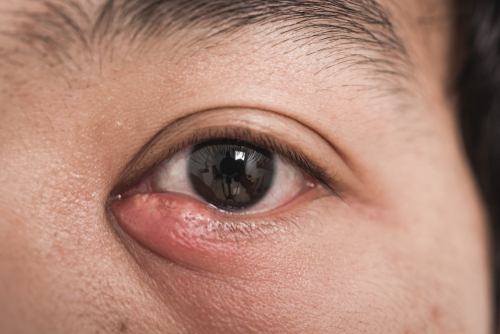A stye, or hordeolum, is an inflamed oil gland on the edge of the eyelid that is typically caused by a bacterial infection. A stye presents itself as a painful, red, and swollen bump on the inside of the eyelid or on the lash line. In the beginning stages of developing a stye, a patient’s eyelid can be irritated, itchy, and painful to the touch. In some cases, a stye can cause a patient’s entire eyelid to swell. This is not only painful and uncomfortable, but it can also impair vision.
Styes that occur inside the eyelid are clinically referred to as internal hordeolum. These are caused by an infection in the oil-producing gland in the eyelid. Styes on the base of the lash line are referred to as external hordeolum. These are caused by an infection in the hair follicle and resemble a pimple.
Styes are not to be confused with a chalazion. Contrary to a stye, a chalazion is a painless bump that develops further back on the eyelid as a result of a clogged oil gland rather than an infection. They are usually painless and they rarely lead to swelling of the entire eyelid.

Risk Factors
Styes are more common in adults because of the thickness of the oil glands that are prone to blockage. There are a few additional factors that increase the likelihood of development as well. These include:
-
Rosacea or seborrheic dermatitis
-
Diabetes
-
Previously having a stye
-
Blepharitis (inflammation or infection of the eyelids)
-
Leaving makeup on overnight
-
Touching your eyes with unwashed hands
-
Lack of contact lens disinfection
-
Using old cosmetics
While some patients are predisposed to the development of styes, there are hygienic habits that can be implemented to lessen the risk of infection.
Treatment
Practicing good hygiene is important in preventing the development of styes. However, if you do develop a stye, do not pop it as this can only increase the risk of infection. Styes will typically go away on their own after about 1-2 weeks. An ophthalmologist might recommend applying a warm compress to the infected eye for 10-15 minutes at a time, 3-5 times a day. In conjunction with this, it is recommended to gently massage the infected eye with a clean finger.
After 48 hours of self-care, symptoms should begin to subside. If there is no change after 48 hours or if you begin to develop swelling in other parts of your face, then you should see an ophthalmologist. They might recommend a topical ointment or injected antibiotics. In some cases, they might drain the eye or give a steroid injection to reduce swelling.
Our oculoplastic surgeons Dr. Aliza Epstein and Dr. Gil Epstein have extensive experience dealing with the eyelids. They can perform an eye exam to determine what treatment is best for you. Contact our office at 954-741-5555 to schedule a consultation.






